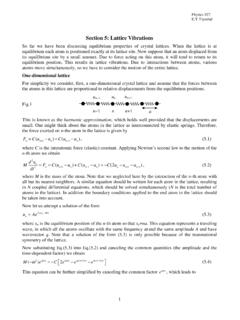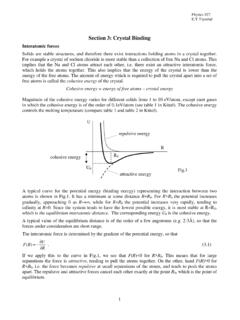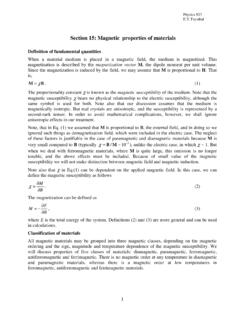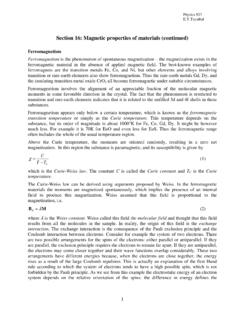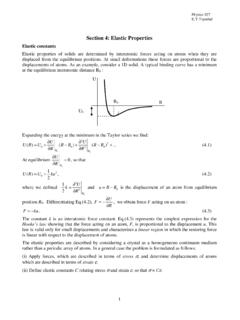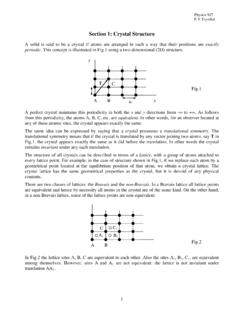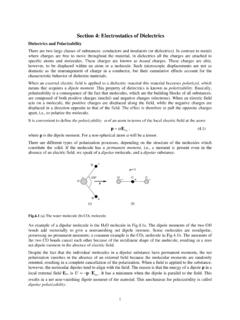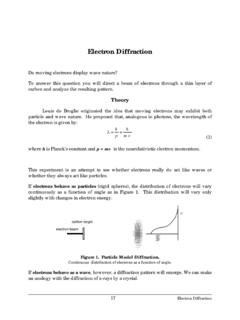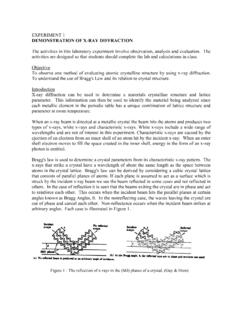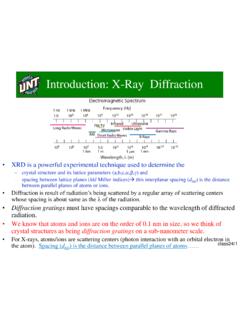Transcription of Section 2: X-ray Diffraction and Reciprocal Lattice
1 Physics 927. Section 2: X-ray Diffraction and Reciprocal Lattice Bragg law. Most methods for determining the atomic structure of crystals are based of the idea of scattering of radiation. X-rays is one of the types of the radiation which can be used. The wavelength of the radiation should have a wavelength comparable to a typical interatomic distance which is in solids of a few angstroms (10-8 cm). The X-ray wavelength can be estimated as follows hc E = h = ( ) = . ( ). E (keV ). Therefore, x-rays of energy 2-10 keV are suitable for studying the crystal structure. X-rays interact with electronic shells of atoms in a solid. Electrons absorb and re-radiate x-rays which can then be detected. Nuclei are too heavy to respond. The reflectivity of x-rays is of the order of 10-3- 10-5, so that the penetration in the solid is deep. Therefore, x-rays serve as a bulk probe.
2 In 1913 Bragg found that crystalline solids have remarkably characteristic patterns of reflected X-ray radiation. In crystalline materials, for certain wavelengths and incident directions, intense peaks of scattered radiation were observed. Bragg accounted for this by regarding a crystal as made out of parallel planes of atoms, spaced by distance d apart. The conditions for a sharp peak in the intensity of the scattered radiation were that: (1) the x-rays should be specularly reflected by the atoms in one plane;. (2) the reflected rays from the successive planes interfere constructively.. d dsin . shows x-rays which are specularly reflected from adjacent planes. The path difference between the two x-rays is equal to 2dsin . For the x-rays to interfere constructively this difference must be an integer number of wavelengths. This leads to the Bragg condition: 2dsin = m ( ).
3 The integer m is known as the order of the corresponding reflection (or order of interference). There are a number of various setups for studying crystal structure using X-ray Diffraction . In most cases, the wavelength of radiation is fixed, and the angle is varied to observe Diffraction peaks corresponding to reflections from different crystallographic planes. Using the Bragg law one can then determine the distance between the planes. The Bragg law is greatly oversimplified (but it works!). It (i) says nothing about intensity and width of X-ray Diffraction peaks;. (ii) neglects differences in scattering from different atoms;. (iii) neglects distribution of charge around atoms. 1. Physics 927. Diffraction condition and Reciprocal Lattice . Later von Layer introduced a different approach for x- ray Diffraction . He regarded a crystal as composed of identical atoms placed at the Lattice sites T and assumed that each atom can reradiate the incident radiation in all directions.
4 Sharp peaks are observed only in the directions and at wavelengths for which the x-rays scattered from all Lattice points interfere constructively. k . T k . k iT k iT. To find the condition of constructive interference we consider two scatterers ( ) separated by a Lattice vector T. Let x-rays are incident from infinity, along direction k with wavelength and wavevector k = 2 k / . We assume that the scattering is elastic, the x-rays are scattered in k . direction with same wavelength , so that the wavevector k = 2 k / . The path difference between the X-ray scattered from the two atoms should be an integer number of wavelengths. Therefore, as is seen from , the condition of constructive interference is (k k )iT = m , ( ). where m is an integer. Multiplying both sides of Eq.( ) by 2 / leads to a condition on the incident and scattered wave vectors: (k k )i = 2 m.
5 ( ). Defining the scattering wave vector k = k k , the Diffraction condition can be written as k = G , ( ). where G is, by definition, such a vector for which G i = 2 m . ( ). A set of vectors G which satisfies this condition form a Reciprocal Lattice . Vectors G are called Reciprocal Lattice vectors. A Reciprocal Lattice is defined with reference to a particular Bravais Lattice which is determined by a set of Lattice vectors T. The Bravais Lattice that determines a particular Reciprocal Lattice is referred as the direct Lattice , when viewed in relation to its Reciprocal . There is an algorithm for constricting the Reciprocal Lattice from the direct Lattice . Let a1, a2, and a3 be a set of primitive vectors of the direct Lattice . Then the Reciprocal Lattice can be generated using primitive vectors 2 2 2 . b1 = a 2 a3 , b 2 = a3 a1 , b3 = a1 a 2 , ( ).
6 V V V. where V = a1 ( a2 a3 ) is the volume of the unit cell, so that 2. Physics 927. G = m1b1 + m2b 2 + m3b3 . ( ). In order to proof that the vectors built in this way satisfy condition ( ), we first note that the bi satisfy the condition b i ia j = 2 ij (i,j=1,2,3) ( ). where ij is the Kronecker symbol defined by ij=0, if i j ( ). ij=1, if i=j . Indeed, since T = n1a1 + n2a 2 + n3a3 we obtain G iT = 2 (n1m1 + n2 m2 + n3 m3 ) , ( ). which proofs Eq.( ). Examples: Reciprocal lattices for 1D and 2D-rectangular structures. Note: Eqs.( ) rather than Egs.( ). should be used in1D and 2D cases. a a2 b2. b b1. a1. 1D 2D. Reciprocal Lattice types for some 3D lattices: Direct Lattice Reciprocal Lattice sc sc bcc fcc fcc bcc hcp hcp Coming back to the Diffraction condition ( ), we can say that constructive interference occurs provided that the scattering wave vector is a vector of the Reciprocal Lattice .
7 It is sometimes more convenient to give a different formulation of the Diffraction conduction. In elastic scattering the photon energy is conserved, so that the magnitudes of k and k are equal, and therefore k 2 = k 2 . Therefore, it follows from Eq.( ) that k 2 = (G + k ) 2 0 = G 2 + 2k G . ( ). By replacing G to -G, which is also a Reciprocal Lattice vector, we arrive at 3. Physics 927. 2k G = G 2 , ( ). that can be considered as the Diffraction condition. Equation ( ) is another statement for the Bragg law (1). We prove this in three steps. (1) We show that the Reciprocal Lattice vector G = hb1 + kb 2 + lb3 is orthogonal to the plane represented by Miller indices (hkl). Consider the plane (hkl) which intercepts axes at points x,y, and z given in units a1, a2 and a3: z v a3 a2 y a1. x u By the definition of the Miller indices we can always find such interceptions that 1 1 1.
8 (h, k , l ) = , , . ( ). x y z . As we know, any plane can be defined by two non-collinear vectors lying within this plane. We can choose vectors u and v shown in They are given by u = ya 2 xa1 and v = ya 2 za3 . To prove that the Reciprocal vector G is normal to the plane (hlk), it is sufficient to prove that this vector is orthogonal to u and v, uiG = 0 and viG = 0 . We have uiG = ( ya 2 xa1 )i(hb1 + kb 2 + lb3 ) = 2 ( yk xh) = 0 , ( ). where the second equation follows from the orthogonality condition of the vectors of the direct and Reciprocal lattices ( ) and the last equation follows from Eq.( ). In the same manner we can show that G is orthogonal to v. We have proved, therefore, that vector G is orthogonal to the plane (hkl). (2) Now we prove that the distance between two adjacent parallel planes of the direct Lattice is d=2 /G.
9 First, we note that the nearest plane which is parallel to the plane (hkl) goes through the origin of the Cartesian coordinates in Therefore, the interplanar distance is given by the projection of the one of the vectors xa1, ya2, za3, to the direction normal to the (hkl) plane. This direction is given by the unit vector G/G, since we have already established the G is normal to the plane. Therefore d = xa1 iG / G = 2 xh / G = 2 / G . ( ). The connection between Reciprocal vectors and crystal planes is now clear. The Reciprocal vector G(hkl). is associated with the crystal planes (hkl) and is normal to these planes. The separation between these planes is 2 times the inverse of G. (3) Now we are ready to show that the Diffraction condition ( ) is equivalent to the Bragg law ( ). It follows from Eqs. ( ) and ( ) that 4. Physics 927.
10 2(2 / ) sin = 2 / d , ( ). or 2d sin = , where is the angle between the incident beam and the crystal plane. The integers hkl that define G are not necessarily identical with the indices of the actual plane, because hkl may contain a common factor m, whereas in the definition of the Miller indices the common factor has been eliminated. Therefore, we can substitute mG instead of G and obtain the Bragg result 2d sin = m . ( ). Brillouin zones. Brillouin gave another statement of the Diffraction condition. Consider a two-dimensional Lattice in the Reciprocal space ( ). Let O be the origin of this Lattice . Consider a Reciprocal Lattice vector, which connects points O and another Reciprocal Lattice site. Now draw the line (in the three dimensions it would be a plane), which is orthogonal to this vector and intercepts it in the midpoint.
